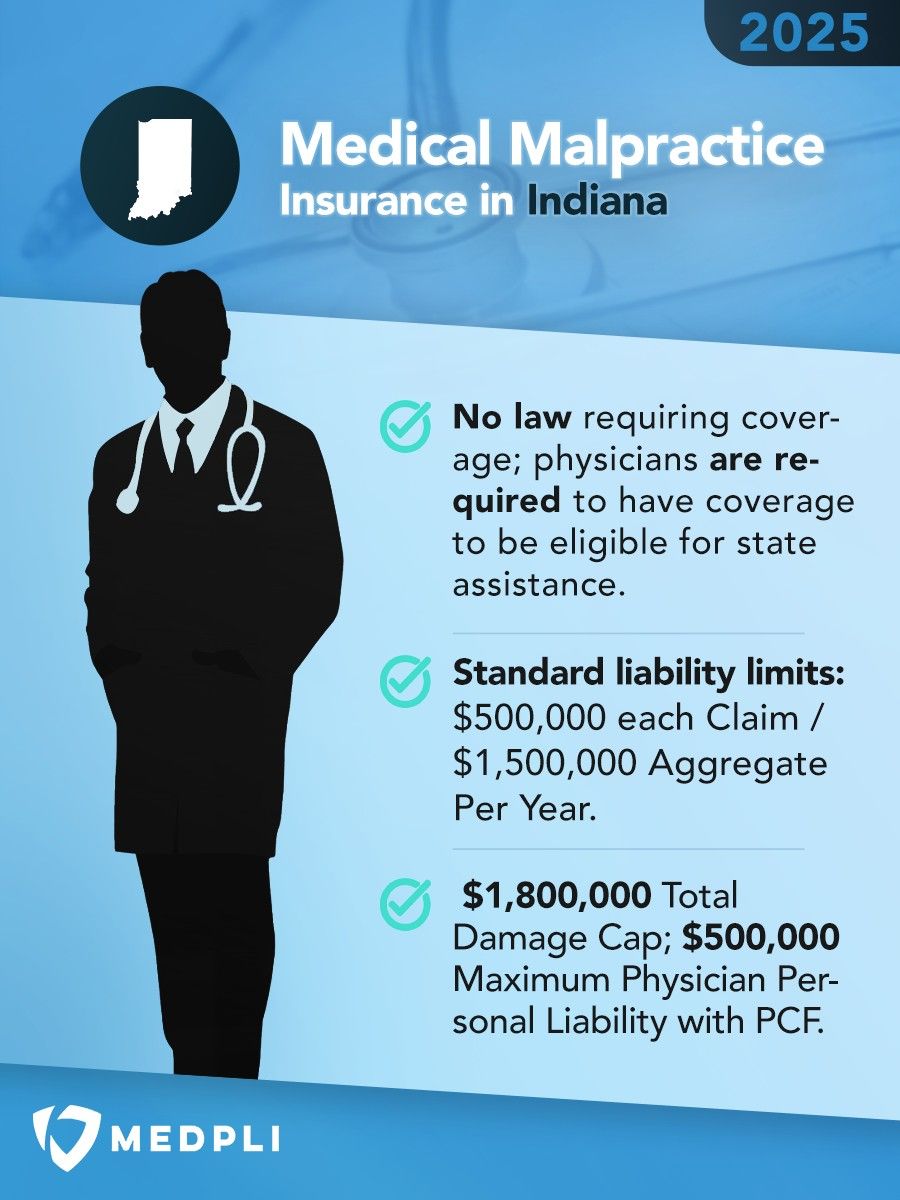Top 6 Medical Malpractice Insurance Carriers in Indiana
We recommend carriers with an AM Best “A” or higher rating. An A-rating indicates financial strength, long-term solvency, and an established history of protecting Indiana physicians.

2025 Indiana Malpractice Insurance Rates by Specialty
These rate estimates are for informational purposes only and are based on the IN standard limits of $500,000 per claim / $1,500,000 aggregate per year in coverage. The PCF Surcharge is in addition to these estimates.
Quotes require a completed application and underwriter approval. Contact us for a custom estimate if you don’t see your specialty.
| Specialty | 2025 Annual Premium |
2025 Tail Premium |
|---|---|---|
| Anesthesiology | $18,000 | $36,000 |
| Cardiovascular Disease– Minor Surgery | $17,000 | $34,000 |
| Dermatology– No Surgery | $7,000 | $14,000 |
| Emergency Medicine | $27,000 | $54,000 |
| Family Practice– No Surgery | $12,000 | $24,000 |
| Gastroenterology– No Surgery | $15,000 | $30,000 |
| General Practice– No Surgery | $12,000 | $24,000 |
| General Surgery | $28,000 | $56,000 |
| Internal Medicine– No Surgery | $12,000 | $24,000 |
| Neurology– No Surgery | $13,000 | $26,000 |
| Obstetrics and Gynecology– Major Surgery | $53,000 | $106,000 |
| Occupational Medicine | $7,000 | $14,000 |
| Ophthalmology– No Surgery | $8,000 | $16,000 |
| Orthopedic Surgery– No Spine | $27,000 | $54,000 |
| Pathology– No Surgery | $9,000 | $18,000 |
| Pediatrics– No Surgery | $12,000 | $24,000 |
| Pulmonary Disease– No Surgery | $18,000 | $36,000 |
| Psychiatry | $7,000 | $14,000 |
| Radiology – Diagnostic | $19,000 | $38,000 |
Indiana Medical Malpractice Payouts From 2015-2024
Nationwide Weather Disasters& Their Impact on Medical Malpractice Costs
When severe storms, flooding, and other major weather events hit, the damage isn’t just physical; it drives up insurance costs nationwide. As extreme weather events become more frequent, insurers must raise rates to cover growing risks. But the impact goes beyond homeowners insurance – businesses, especially medical professionals, also feel the squeeze.
Why Are Insurance Rates Rising?
How Indiana’s Medical Malpractice Rates Are Impacted
Reinsurance providers now charge higher premiums and impose stricter payout conditions. In response, primary insurers, including those offering medical malpractice coverage in Indiana, have increased premiums.
Though Indiana’s tort reform has helped keep premiums low compared to many other states, Indiana is not immune to significant weather events, and physicians should prepare for future increases. Severe weather isn’t just a coastal problem; it’s reshaping insurance costs for everyone.
Types of Professional Liability Insurance for Indiana Physicians
Doctors in Indiana can choose between these two types of primary medical malpractice insurance:

- Provides coverage for incidents that occurred during the policy period IF the claim is filed while the policy is still active. If a claim is filed after the policy ends, that claim is NOT covered.
- Typically, it offers lower premiums at the start of the policy, but rates increase yearly as the policy matures.
- Tail insurance coverage when a claims-made policy ends to ensure protection against future claims related to incidents that occurred during the policy period. Tail insurance premiums require a one-time cash payment equal to approximately 200% of the claims-made policy’s annual premium.

- Provides coverage for incidents that occurred during the policy period, regardless of when a claim is reported to the carrier.
- Typically, it offers more costly premiums at the start of the policy, but the rate stays constant throughout the policy’s duration.
- Physicians do not need tail coverage when an occurrence policy ends.

3. Additional Required Coverage: Patient Compensation Fund (PCF)
- Backstops primary limits by covering judgments and settlements above the physician’s malpractice policy limits.
- Reduces a physician’s out-of-pocket exposure and guarantees full patient recovery up to statutory caps.
- All Indiana-licensed physicians must carry at least the state-mandated minimum malpractice limits and pay an annual PCF surcharge, which varies by specialty.
Reach out to an experienced MEDPLI insurance broker who will do the work for you to find a tail policy at a great price.
In 2024, Indiana physicians were held liable for 304 medical malpractice payouts.
- Average Payout: $259,779
- Total Payout: $78,973,000
(Source: National Practitioner Data Bank)
Does Indiana Have Damage Caps for Medical Malpractice Lawsuits?
Yes. Under Title 34, Article 18 of the 2024 Indiana Code, the total recoverable damages in a medical malpractice action are capped at $1.8M for incidents occurring after June 30, 2019.
Unlike many states that only cap noneconomic damages, Indiana’s cap applies to all damages, including economic and noneconomic.
Key Rules:
- Maximum Total Payout: $1.8 million per claim.
- Physician’s Responsibility: The first $500,000 is covered by the physician’s primary malpractice insurance.
- PCF Contribution: The Patient Compensation Fund (PCF) pays up to $1.3 million beyond the primary limits, covering claims that exceed the $500,000 threshold.
PCF Eligibility
To qualify for PCF coverage, physicians must:
-
- Carry at least the state-mandated minimum medical malpractice insurance limits.
- Submit a Certificate of Insurance to the Indiana Department of Insurance (IDOI).
- Pay the annual PCF surcharge, which varies by specialty.
How Indiana’s Malpractice Laws Have Evolved
- 1970s: A nationwide medical malpractice “crisis” led to increased malpractice cases and a surge in insurance costs.
- 1975: Indiana passed the Medical Malpractice Act, becoming the first state to pass medical malpractice reform. The act established damage caps, panel review, statute of limitations, and the PCF.
- 1990s-present: Increased damage caps and PCF contribution limits.
Indiana Favors Physicians in Malpractice Cases
Indiana ranks among the best states for doctors due to high salaries, strong legal protections for healthcare providers, and some of the lowest malpractice rates in the nation. The Indiana Medical Malpractice Act and subsequent amendments have:
- Maintained strict caps on combined damages.
- Kept physicians’ liability low with PCF contributions.
- Required expert panel review, reducing the number of meritless claims.
- Helped keep malpractice premiums low compared to other states.
Indiana’s legal landscape protects patients’ rights while maintaining one of the most physician-friendly environments in the U.S. High damage caps ensure patients can receive adequate compensation for damages. In contrast, the PCF protects physicians from personal liability and excessive payouts.
Indiana Statute of Limitations for Medical Malpractice Claims
Indiana Code 34-18-7-1 states that malpractice actions must be filed within 2 years from the alleged malpractice, omission, or neglect. Unlike in many other states, Indiana has very few exceptions to this rule.
Exceptions:
- Minors: Minors under six when the incident occurred have to file until the child’s eighth birthday.
- Panel Review: Filing a complaint with the IDOI tolls the statute until 90 days after the claimant receives the panel’s opinion.
Why Indiana Doctors Partner with MEDPLI
We exclusively broker medical malpractice insurance, focusing daily on making the professional liability process less burdensome and expensive for doctors.
With MEDPLI, Indiana physicians:
MEDPLI helps doctors in every specialty.
Whether you’re a Bariatric Surgeon in Indianapolis or a Cardiologist in Madison, MEDPLI will find you premier coverage at a competitive rate.
Call 800-969-1339 or Request a Quote.
About the Author
Max Schloemann is a medical malpractice insurance broker helping physicians and surgeons secure Medical Professional Liability coverage. A Magna Cum Laude graduate of Southern Illinois University’s College of Business, he was named Outstanding Management Senior.
Max began his career in 2008 at an industry-leading firm and founded MEDPLI in 2017 to guide private practice doctors and physicians in transition through the complexities of malpractice insurance.
Outside of work, Max, his wife Kristen (a Physician Assistant), and their four kids enjoy the outdoors and attending the kids’ sporting events. For malpractice insurance questions, you can contact Max here.
Latest from the Medical Malpractice Insurance Blog
View our 2026 Georgia medical malpractice insurance rates by specialty, carriers, payouts & state regulations. Get your custom MEDPLI quote today.
Explore 2026 Illinois medical malpractice insurance costs, top A-rated insurers, payout trends & the latest state regulations. Get your free quote today.
GUIDE: Overview of New York medical malpractice insurance rates by specialty, top carriers, payout statistics, and state regulations. Get a custom quote here.
See 2026 California medical malpractice insurance rates by specialty, carriers, payouts, and regulations. Get your custom MEDPLI quote today.







